Forget sparkling conversation or good table manners: one of the most important qualities in a dining companion, as far as I'm concerned, is a fear of tentacles. As the late, great Alan Davidson put it, "cephalopods are eaten less than they might be because some people are repelled by their aspect" ? a fact that works out well for me if I order a plate of calamari, puntillitas or salt and pepper squid for the table.
Grilled over wood, stuffed and roasted, slow-cooked in a stew: I love squid in all its forms (even the mysterious giant versions are weirdly fascinating) but none is more addictive than the deep fried version most commonly known as calamari. Pringles be damned: who can leave a hot, crisp cluster of tentacles on the plate?
A cut above
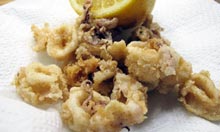 Nigella Lawson recipe calamari. Photograph: Felicity Cloake
Nigella Lawson recipe calamari. Photograph: Felicity Cloake I like the tiny squidlets which can be fried whole, tentacles and all, but they're hard to get hold of in this country and I don't find any recipes calling for them. I'm going to stick with the squid rings that, when badly cooked, have caused calamari to be compared to rubber bands. I prefer the slightly thicker, 1cm slices suggested by Nigella to the slimmer, more elegant 5mm rings used by chef Tom Aikens and Italian cookery writer Marcella Hazan: there's more squid to get your teeth into. I'm also going to chop some of the pieces into flat triangles too, a cut more commonly used for Chinese salt and pepper squid, to provide a variety of textures (not that calamari really needs much more to keep me interested.)
A chef (whose name I sadly missed as I was shovelling squid into my mouth at the time) once told me that the best way to ensure tender squid is to freeze it first; not a problem in the many places which sell "fresh" stuff which actually, when you get it home, is full of shards of ice. Chewiness is rarely too much of a problem with smaller squid in any case: it's the big fellows you have to watch out for.
The marinade
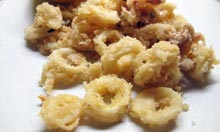 Tom Aikens recipe calamari. Photograph: Felicity Cloake
Tom Aikens recipe calamari. Photograph: Felicity Cloake Aikens marinades the squid in a mixture of garlic, lemon zest, rosemary and olive oil for a day before cooking. While these are all, with the possible exception of rosemary, flavours I'd pair with squid, I prefer them as an accompaniment. They do nothing to soften the meat, and I want the squid itself to taste of squid, pure and simple.
Mitch Tonks dips his squid in milk before coating it in flour in his Fish Easy book: I don't find this makes much difference to the meat although the batter is very slightly sweeter and browner, but I read online that soaking the squid in milk for an hour before cooking is thought to tenderise it. I give it a try and find that it does indeed: my calamari still have bite, but they're definitely less chewy.
The batter
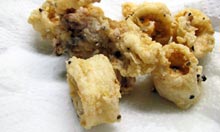 Mitch Tonks recipe calamari. Photograph: Felicity Cloake
Mitch Tonks recipe calamari. Photograph: Felicity Cloake The main difference between calamari recipes is, of course, the coating. They range from the blissfully simple (Hazan's plain, unseasoned flour) to the very slightly more complicated. Nigella tosses hers in a mixture of semolina and cornflour, Tonks uses equal parts of corn- and 00 flour, Aikens chooses self-raising flour and Slater wins the prize for the most complicated with his tempura-like batter using egg yolk, mineral water and flour. And that still only takes a second to mix together. It's dangerously easy, this calamari lark.
After much thoughtful chewing, I decide I prefer a lighter coating: Slater's voluminous batter and Nigella's slightly gritty mixture are all too much of a distraction here. The self-raising doesn't seem to add much ? Hazan's plain flour is just as good, but crispest of all is Tonks', with its fine-ground and cornflour combination. After a bit of experimentation, I decide that actually, the cornflour is what makes the difference here: the 00 is a red herring.
The flavourings
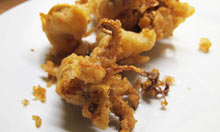 Nigel Slater recipe calamari. Photograph: Felicity Cloake
Nigel Slater recipe calamari. Photograph: Felicity Cloake I don't think you want to muck about too much with calamari. Garlic in the coating, as used by Aikens, simply burns, while Slater's smoked paprika imparts a richer colour but also, as one of my testers observes, an "odd meaty taste". Nigella uses American Old Bay seasoning, familiar to me from my forays into fried chicken, suggesting salt and paprika as a substitute, but I think a little salt is all the squid needs. Sprinkling them with extra salt flakes fresh out of the pan, as Hazan suggests, adds extra crunch.
The cooking: squid's in
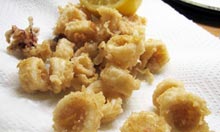 Marcella Hazan recipe calamari. Photograph: Felicity Cloake
Marcella Hazan recipe calamari. Photograph: Felicity Cloake Everyone deep fries their squid in vegetable oil, apart from Hazan, who uses just an inch, turning the rings halfway through. I can't see the benefit of this: the fewer interactions I have with hot fat, the better, and as she uses a frying pan rather than a saucepan, there's not much less oil involved.
Mark Bittman offers some excellent tips for squid frying in the New York Times, suggesting patting the pieces dry before flouring them. Although this definitely makes the squid spit less, it's hard to get flour to stick if you're too diligent: OK if you like the very minimalist coating favoured by Bittman, not so great if you prefer a bit more crunch. Not overcrowding the pan, as I do on my first few attempts, is vital for crisp results: too many squid pieces in there, releasing water, and they'll steam rather than fry.
Perfect calamari
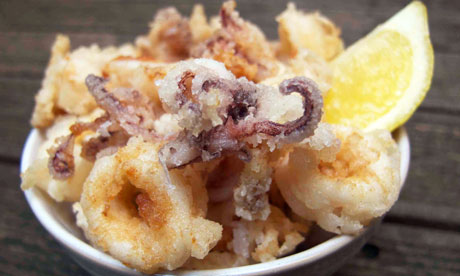 Felicity's perfect calamari. Photograph: Felicity Cloake
Felicity's perfect calamari. Photograph: Felicity Cloake Accompaniment-wise, people seem to like a squeeze of lemon, but I'm not sure you can beat a really garlicky mayonnaise for dipping. You might well find the same people who squirm at the idea of tentacles don't really care for garlic either.
Serves 4 as a starter, 2 as a main course
400g cleaned squid, tentacles and all
Milk
4 tbsp cornflour
4 tbsp plain flour
1 tsp salt
Sunflower, vegetable or groundnut oil, to cook
Salt flakes, to serve
Lemon wedges or garlic mayonnaise, to serve (optional)
1. Remove the tentacles from the squid and cut the bodies into thick rings, about 1cm in diameter, and large triangles. Score the triangles with a criss-cross pattern. Put the pieces and tentacles into a bowl and cover with milk, then cover the bowl and refrigerate for up to 8 hours (even half an hour is better than nothing).
2. When you're ready to cook, mix together the flours and salt in a shallow container. Fill a large, heavy based pan a third full with oil and heat over a medium-high flame until a pinch of flour sizzles when it hits the oil.
3. Drain the squid well, and perfunctorily pat dry, then drag through the flour and shake off the excess. Fry in batches for about a minute, until crisp, and slightly golden. Place on kitchen paper, sprinkle with salt, and then serve each batch as soon as they're ready, with lemon wedges or garlic mayonnaise.
Do you love or loathe our cephalopod friends? If the latter, what is it about them you object to, and if the former, which other squid recipes tickle your tentacles?
Source: http://www.guardian.co.uk/lifeandstyle/wordofmouth/2012/oct/11/how-to-cook-perfect-calamari
dallas mavericks washington capitals delmon young amare stoudemire tallest building in the world the pitch brandon inge
No comments:
Post a Comment
Note: Only a member of this blog may post a comment.